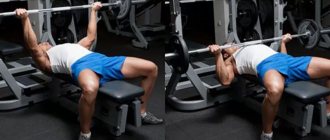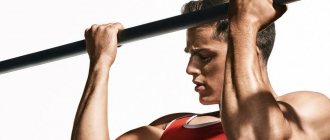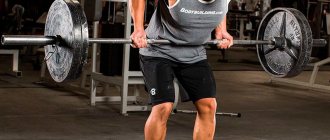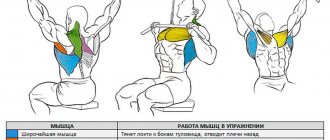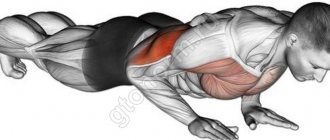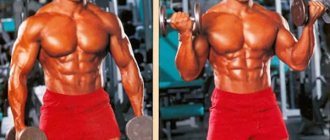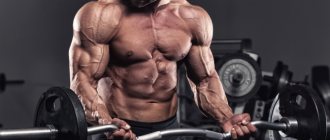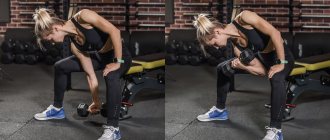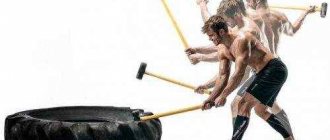This exercise, despite the obvious name, is not for biceps, but for brachioradialis. The brachioradialis muscle makes the forearms more voluminous. In life, it helps to strengthen your grip, hold heavy weights, do more active pull-ups on the horizontal bar, carry huge bags, and generally look great. After all, there is nothing sadder than the combination of a huge bicep and a small but proud forearm. The exercise is often done by bodybuilders, but in fitness training it is less common. But in vain, it would help solve most of the problems with pull-ups and hanging on horizontal bars. How to do reverse grip raises correctly?
Why do the exercise
In bodybuilding, the main movement for working the biceps is considered to be the classic barbell curl. This is completely justified, since the movement is not only mass-forming, but also useful for the development of strength qualities. The reverse grip barbell lift is a variation whose main purpose is to shift the load to those areas that are poorly used in the basic version of the movement.
The main advantages of using a reverse grip:
- Increasing the volume of the biceps (with an emphasis on the outer head).
- Strengthening the muscles and increasing the volume of the forearm.
- Increasing strength in other exercises by strengthening hand strength.
The disadvantages of reverse curls are mainly due to incorrect technique and a lack of understanding of the key features of the exercise. This applies to the weight used, range of motion, tempo and other technical conditions.
Benefits of doing the exercise
To help you decide whether to include this exercise in your workout routine, here are some of the main reasons why the benefits of performing reverse-grip barbell curls are most apparent.
- By performing this exercise technically correctly, you will significantly increase the muscle mass of your arms. As we have already said, the load on the biceps is much less; the lion's share of the load is taken by the muscles of the shoulder and forearm. A well-developed brachialis muscle visually “pushes” the biceps outward, which allows you to increase the volume of the arm and increase the peak strength of the biceps.
- Well-trained forearms improve our grip and help us hold the barbell in a static, stationary position, such as when performing deadlifts or bent-over barbell pull-ups.
- You should also take into account the fact that arm muscles love variety in training. If you don't change your training program for several months, you will most likely stop noticing progress in gaining mass and strength very quickly. Lifting the barbell with a reverse grip helps with such stagnation.
Biceps and forearms that are accustomed to monotonous work in one plane will receive a very large load, and in the long term this can lead to serious progress. Of course, provided that you distribute the load correctly, eat well and recover.
We recommend performing reverse-grip barbell curls every 2-3 workouts to regularly shock your muscles. It is better to do this at the end of an arm workout - this way you will “finish off” tired biceps, and the positive effect will not be long in coming.
What muscles work
When working with a reverse grip with a barbell, the main load falls on:
- Biceps brachii muscle.
- Brachialis.
- Brachioradialis muscle.
also as stabilizers when lifting a barbell with a reverse grip:
- Anterior delta.
- Trapezoid (upper and middle parts).
- Wrist flexors.
Crossfit training complexes
| Old hardcore | Do the following exercises:
You must complete the maximum number of rounds in 7 minutes. |
| Happy 100 | Perform the following exercises according to the 30-25-20-15-10 scheme:
|
| Arnie | Perform 5 rounds of the following exercises:
|
Execution technique
Technically, the reverse-grip curl is not much different from the regular classic biceps curl, except for the change in the position of the hands and forearms.
Standing technique:
- Take the barbell in your hands with a reverse grip, palms facing you.
- Stand straight with your feet shoulder-width apart. The back is straight, the gaze is directed forward (without skewing the neck forward or backward).
- Slowly lift the bar until your fist is level with your front deltoid.
- Take a short pause and lower the bar to the starting position at a slower pace.
The peculiarity of the movement is that, unlike the classic version with a straight grip, when doing reverse arm bends it is extremely important to fully straighten the arms, that is, the amplitude includes full extension of the elbow. Otherwise, the efficiency of movement will decrease, and the load on the elbow joint will also increase.
Standing dumbbell curl
The following exercise is for developing biceps. It can be either the main exercise for training or a “finishing exercise”. The exercise is unilateral, that is, it can be performed with one hand.
Initial position:
- Stand up straight
- Pick up dumbbells
- Lower your arms along your body
- As you exhale, bend one arm at the elbow, raising the dumbbell to your chest
- as you exhale, lower slowly
- Then do the same with the other hand.
- Continue doing the exercise with each hand alternately
- When lifting the dumbbell to your chest, turn your hand towards you
The exercise can be performed alternately, or you can lift dumbbells at the same time.
Which neck to choose
- If the athlete has a choice, when lifting the barbell with a reverse grip, you should always give preference to the EZ bar . It is more anatomical and allows you to work more efficiently with the same weight, unlike a straight bar. Also, the curved bar helps reduce stress on the hands, which is especially important when working with heavy weights.
- However, for high rep sets where lighter weights are used, a straight bar . Choose the distance between your hands on the bar so that the wrist twists as little as possible, this will help partially offset the loss of efficiency compared to the EZ bar.
Hammer curls for biceps (hammer)
Another exercise that develops the brachialis.
Initial position:
- Take dumbbells in your hands with your hands facing you.
- As you exhale, bend your elbows and lift the dumbbells to your chest.
- The position of your hands should be as if you were holding a hammer in your hand (hence the name).
- As you inhale, slowly lower your arms.
This exercise can be performed with both hands together or alternately. You can also do it both standing and sitting. When performing while sitting, you will not be able to cheat much by swinging your body.
Common mistakes
Major mistakes that slow down progress or increase the risk of injury:
- Performing the movement at a fast pace. The speed of lifting and lowering the weight with a reverse grip is greater than with a straight grip.
- Using heavy weights – often athletes, especially beginners, chase weight. As a result, when lifting, a large share of the load falls on the shoulders and even the back muscles.
- Incomplete range of motion, which harms the elbow joint and does not provide any benefits.
- When lifting an EZ bar with a reverse grip, a wide hand position (with the thumb pointing down) is used. Holding the barbell with your thumbs down is a mistake that can potentially lead to injury.
Incorrect reverse grip lifting technique
- Body sway and inertia to facilitate movement.
- Raising the bar too high – it is anatomically impossible to bring the bar to the same height as when working with an overhand grip. This is especially evident with large biceps, so you should not try to bring the bar above the “dead point”, this will distort the technique.
Contraindications
Inflammatory processes in the elbow joints and wrists are a limiting factor. They do not allow you to take significant weights and limit the movement itself. Usually, in case of inflammation, it is recommended to exclude biceps curls in any variant, or to perform a “rehabilitation” version with a rubber shock absorber of medium resistance.
Injuries such as biceps avulsions and tears also serve as a limiting factor for those wishing to perform this exercise. In this case, general access to the training is granted by a doctor.
How to include in training
Basic rules for introducing movement into the training process:
- Despite the different directions, it is better to alternate presses with direct and reverse grips, performing them on different training days. This will allow you not to exceed the permissible training volumes and pump all the muscles.
- Alternate working with barbells and dumbbells for weeks. Changing the equipment will allow you to add variety to the training process.
- Perform 3-4 sets per workout, it is recommended to do the last set on failure.
- In the strength version, it is optimal to do 8-12 repetitions, in the multi-repetition version - from 12 to 20, depending on the weights used and the level of physical fitness.
- The movement can be performed either at the beginning or at the end of the workout, but only after a thorough warm-up.
Tips for beginners
- It will be easier to prevent cheating with your body if you press your back and shoulder blades against the wall. The swing can be removed by pressing your spine against the vertical stand of any exercise machine, or support. At first, it’s easier to learn how to include the biceps in your work;
- The shoulder muscle works better if a straight bar is used. But for those whose hands hurt during the exercise, a curved bar is suitable. It will help relieve stress from your wrists and make the exercise more comfortable;
- To strengthen your grip, you can use bar extensions, or perform an exercise on the Apollo Axel axis. This will help if the goal is strength work with a barbell, or a lot of pull-ups on the horizontal bar without straps;
- Ideally, the weight should be selected so that most of the repetitions take place in the middle of the amplitude. Just as “dead hanging” a barbell at the bottom is pretty useless, so is throwing it to the very top;
- It is better to place your feet loosely on the floor, but wide enough so that there are no problems with swinging. When performing static leg lifts, it is better to turn them on, resting them on the floor;
- Those who have priority hypertrophy of the brachioradialis and brachialis muscles can use the help of straps so as not to drop the barbell
Anatomy
The reverse grip press is a very convenient and correct exercise from the point of view of human anatomy, since it does not force the athlete to load and twist his hands, which allows him to remove the load almost completely. In addition, the position of the hands creates a supination effect, which increases the load on both the triceps and biceps, due to which the arms are constantly in tension, which forces the body to use glycolysis to supply energy to muscle fibers.
The joints, on the contrary, are relatively unloaded, since almost the entire load falls only on the arms, and this does not allow working with large weights, but the intensity of the load is much higher than when it is distributed over a large number of muscles, especially since “failure” occurs precisely in the target muscle group, because she takes on the entire load.
Other exercises
